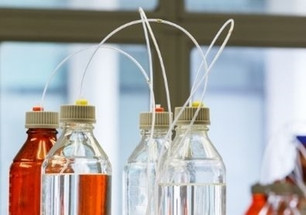Posted by Chrom Tech on 15th Oct 2025
Offline vs. Online Degassing of HPLC Solvents
Gas bubbles and outgassing can significantly affect HPLC performance. Outgassing occurs when the dissolved gas concentration exceeds the solvent’s absorption capacity. Variables such as temperature, pressure, and solvent composition all influence gas solubility. Rough internal surfaces within the HPLC system can also act as nucleation sites for bubble formation. These bubbles can cause retention time shifts, unstable baselines, inconsistent peak areas, and even pump failures—reducing both accuracy and reproducibility.
Offline vs. Online Degassing of HPLC Solvents
Offline Degassing
Offline degassing is performed before the mobile phase enters the HPLC system. The most common method is helium sparging, where helium gas is bubbled through the solvent to displace dissolved air. While effective, offline degassing allows the solvent to gradually reabsorb gases once exposed to air, reducing its long-term stability.
To protect against contamination, use a solvent inlet filter—typically a 2 µm filter—to prevent particulates from entering the reservoir and improve sparging efficiency. Maintaining slight system back pressure helps prevent bubbles from reforming at atmospheric pressure. Installing a back pressure regulator after the detector minimizes bubble formation and ensures consistent flow (check your detector’s pressure rating before installation).
Online Degassing
Online degassing continuously removes gases during operation, eliminating reabsorption and ensuring consistent solvent quality. The most common technique uses a vacuum degasser integrated into the system. The mobile phase flows through a gas-permeable membrane where dissolved gases such as oxygen and nitrogen are extracted under reduced pressure. This results in stable baselines, consistent retention times, and improved reproducibility.
As with offline methods, bubbles can still form when pressure drops after the column. Installing a back pressure regulator downstream of the detector minimizes this issue and helps maintain steady flow through the cell.
Choosing the Right Degassing Method
Both offline and online degassing methods improve HPLC reliability, but their applications differ:
- Offline degassing methods (such as helium sparging, ultrasonication, or vacuum treatment) are simple and inexpensive but allow for reabsorption once solvents are exposed to air.
- Online degassing with a vacuum membrane device offers continuous, maintenance-free gas removal—making it the industry standard for modern HPLC systems.
For long analytical runs or gradient methods, online degassing provides the most reliable performance. If your current system lacks one, Chrom Tech can help integrate a high-quality vacuum degasser to improve your analytical precision and instrument stability.
Finally, remember that HPLC solvents are considered hazardous waste under FDA and EPA regulations. Always collect used solvents in approved solvent waste containers to ensure safe and compliant disposal.
Frequently Asked Questions About HPLC Solvent Degassing
Why is degassing necessary in HPLC?
Degassing removes dissolved gases that can cause noise, pressure fluctuations, and bubble formation in the pump or detector cell—helping maintain stable baselines and accurate retention times.
Which method is more reliable—offline or online degassing?
Online degassing is more reliable for high-precision or long-term applications because it continuously removes gases during analysis, unlike offline degassing, which can allow reabsorption after setup.
What type of degasser is most common in modern HPLC systems?
Vacuum membrane degassers are the most widely used. They efficiently remove oxygen and nitrogen from solvents in real-time before entering the HPLC pump, providing consistent flow and baseline stability.

